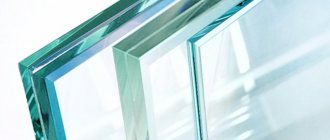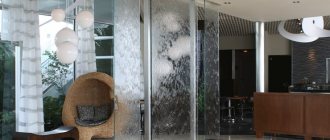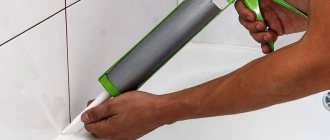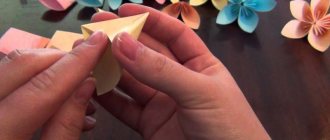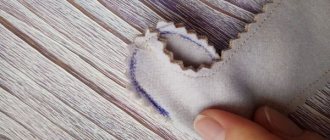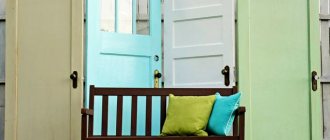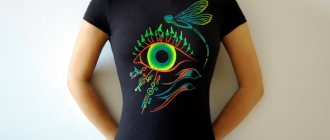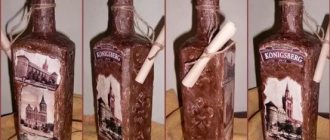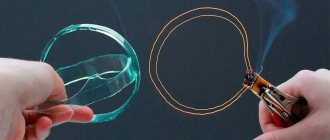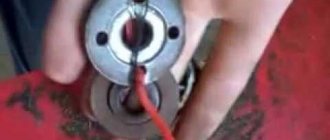Dear friends, subscribers and blog visitors!
In my creative work I use almost all known glass painting techniques with stained glass paints. Don’t be surprised, it’s not difficult, because there are not so many of these techniques: contour, non-contour and multi-layer.
Sometimes dot painting on glass is also used - this is perhaps the only basic technique that can be combined both with stained glass painting and separately as a point-to-point on other surfaces
Glass painting technique
In the photo above, I am working on a glass painting. The most amazing moments in the life of an artist are the moments of creating works... on glass, canvas or wood. Let's take a closer look at these techniques today and figure out what the specifics of each of them are and what opportunities they open up for artists. You will see that due to the effects obtained when using each technique, you can create completely different stained glass paintings with the same paints.
Let's start with the most common...
Contour painting technique
Its essence lies in the fact that first a contour painting is done on glass , a sketch of the work is created, and then the spaces between the contours are filled with paints, as a result of which a picture is born.
The drawing is outlined with a relief outline, preferably from the same company that makes stained glass paints. If the surface is large enough, stained glass lead tape is used, which plays the same role as the outline - it does not allow the stained glass paint to mix and strictly adhere to a certain place.
Examples of masters in stained glass painting using contour
This is a matter of your taste... If you want to make the divisions in the drawing wider and similar to those in a real stained glass window, then choose stained glass lead tape. If you want your work to be airy and light, choose a contour in a tube.
The height of the outline depends on how much paint you plan to pour onto the glass. But the denser the paint, the less transparent it is.
Tip: stained glass paint is an amazing material; you can use it to create colorful works, and not only on glass. Practice on small pieces of glass with different densities of paint on the glass using different height outlines…. Perhaps you will discover something new for yourself!
In principle, all life is built on experiments. Experiment and live life to the fullest. And as Aristotle correctly noted: “To live means to do things, not to acquire them!”
You can get your hands on stained glass painting on small glasses, plates and vases
The advantages of this technique: the ability to see a sketch of the painting before filling it with colors, a certain schematic nature that allows you to break the process into separate stages, and the characteristic “stained glass” appearance of the final work.
Watch the video story “ How you can decorate an interior with stained glass painting” using the example of a large painted stained glass window, made to order by me, and take note.
New Year's drawings-stencils for cutting
The easiest way to make templates is to print them from the Internet. If you don’t have a printer, and you plan to make the drawing large, you should contact a printing studio, where they will make the necessary stencil. You can even print white snowflakes and glue them to the window. This will be the simplest decor option.
Working with stencils
To make a stencil yourself, you need to prepare thick cardboard or plastic, a stationery knife, a cutting board (preferably glass), an eraser, a simple pencil, and scissors. Then the drawing you like must be printed and enlarged on cardboard, or drawn by hand (you can use data from the Internet). The finished stencil is cut out with a knife or scissors, placing a cutting board on top.
Next, work with stencils like this:
- choose the best place on the window;
- apply a stencil;
- glue it with small pieces of paper tape;
- perform the drawing.
New Year's decor does not end with glass decoration. Windows can be made truly New Year's by decorating cornices, window sills, and curtains. For example, paper snowflakes, rain, and Christmas tree balls are pinned to curtains and tulle. You can put candles in beautiful candlesticks on the windowsill, and self-made paper garlands are glued to the cornices. This composition will be an original solution for the New Year and will attract the attention of guests.
Non-contour technology
The peculiarity of stained glass paints is that they spread strongly over the glass. If you use them without contours, you need to control this spreading and, in fact, create a picture precisely due to it.
When applied, paints not only spread, but also mix with each other, creating new shades, stains and unclear boundaries. It turns out a little like a typical watercolor, only varnished.
Here is an example of stained glass abstraction, this is a blank for continuing the painting
This technique is more difficult than the previous one and takes a long time to master. It varies greatly depending on the brand of paint and the degree of dilution, and the application itself is difficult and time-consuming.
By the way, if you have not yet decided what stained glass paints you would like to use to paint your products, then a review article on stained glass paints can help you with this.
In general, this is a technique for curious people. It is best to use varnish stained glass paints to create beautiful paintings using the non-contour technique; they open up more opportunities in the world of stained glass painting.
By the way, these two techniques can be combined. For example, inside a large element in an outline you can make a pattern in a non-outline manner. And of course, flowers turn out especially beautiful when the spreading of stained glass paints creates amazing patterns inside the flower!
In a master class on painting a glass table, I show all the nuances of such work. The photo below clearly shows how beautiful spreading is created in this way.
Fragment from a lesson on painting a table
You can purchase a video tutorial on stained glass painting a glass table Also in this lesson I additionally show the technique of gilding with gold leaf, since gilding complements this work.
As you know, hand made is a special type of creativity and it is popular all over the world, because many people like to decorate the interior with their own hands.
How to draw frosty patterns and fairy-tale designs on the window for the New Year of the Dog 2022
The tradition of decorating windows for seasonal holidays dates back to ancient times. Then the Celtic peoples decorated shutters and window openings with spruce branches to drive away evil and evil spirits. Later, the Chinese continued the custom, decorating doors and glass for winter holidays with ringing objects - bells, coins, bells. And only during the reign of Peter I, the New Year's ritual of applying thematic drawings to windows appeared on the territory of Russia.
Years passed by decades, following the period of the Soviet Union, today's modernity came, New Year's traditions changed but remained revered by every family. Our grandparents decorated the windows of their houses and schools with paper snowflakes, our mothers and fathers decorated the glass with cotton balls, and we painted them with glue or gouache paints. It's time to teach your own kids how to draw frosty patterns and fairy-tale drawings on the window for the New Year 2018. DIY dogs at home, at school, in kindergarten.
The easiest ways to paint a New Year's window with your own hands
Fabulous drawings and frosty patterns on the windows will fill the house with an indescribable atmosphere on the eve of the New Year of the Dog 2022. Professional artists, using ordinary paints, can create real masterpieces on glass. And for simple lovers of beautiful scenery and creative pastime, simpler thematic plots can be used:
- snowflakes and frosty patterns;
- Father Frost, Snow Maiden, Snowman;
- elegant Christmas tree and Christmas decorations;
- New Year's garlands, fireworks, serpentine;
- a sleigh with gifts pulled by reindeer;
- Christmas angels;
- fairy-tale and cartoon characters;
- animals in winter scenes;
- one-component designs (candle, bells, Santa's boots, gift box, etc.).
Any of these holiday illustrations come in snowy white, solid colors, or multicolored designs. To decorate them, you can use additional elements: glitter, tinsel, beads, paper parts. And if fine art is clearly not your talent, use homemade or ready-made templates and stencils. With their help, you will be able to use more interesting techniques in decorating the New Year's window:
- Pasting glass with paper protrusions with fairy-tale motifs;
- Transferring small monochromatic designs through a stencil using white paint or artificial snow from a balloon;
- Applying “frosty patterns” with a small soap with a sharp end;
- Independent painting of window glass with gouache or stained glass paints;
- Artistic decoration of glass with splashes or strokes of toothpaste;
- Painting windows for the New Year with large scenes or panoramas by applying an even layer of toothpaste and gradually erasing and scraping out the necessary details;
- Painting with hot silicone and sprinkling patterns with small sparkles.
Multilayer technique
The essence of this painting technique is clear from its name: paint is applied in several layers. Moreover, depending on what effect the artist wants to achieve, the bottom layer (or several layers) can be either completely dry or of varying degrees of dampness, so that they are mixed with the layer applied above.
This technique allows you to create the most realistic images using stained glass paints; with its help you can even convey shadows and the play of light. This technique requires a lot of attention and patience.
Water-based stained glass paints are best suited for this technique. Although, if you practice enough, you can achieve good results with varnish stained glass paints.
A short review of brands and manufacturers of organic-based stained glass paints (varnish) will help you make the right choice when purchasing.
Here, look at the example of the work of one master of stained glass painting, where you can clearly see the transitions of light and shadow on the boy’s face and on the bodies of the angels.
Examples of stained glass multilayer technique
Consistency in work and accuracy are important here... If errors appear, it will be difficult to correct them. And I repeat again - try, experiment! After all, nothing is impossible - anyone can master such a subtle technique... the main thing here is desire!
Types of decorative glass processing
Today, the use of about five technologies for processing glass products and about two dozen types of external finishing is known. Let's look at the most interesting and effective ones.
Glass yarn - made from glass threads that are wound onto glass products. The main object can be of a different transparency or color, and the threads can be used to form a mesh, spirals, or feathers. When thin hollow needles are injected into the material using a special syringe, transparent sparkling threads form a filigree called “a thousand flowers”.
Ice glass is obtained by immersing the workpiece in cold water, as a result of which random cracks form on the surface. When the glass has cooled, it is heated again and the products are blown.
Laminated glass is created from a blown blank, which is dipped in turn into glass masses of different colors. Next, the product is sanded, it can be made openwork or matte. This type of decorative glass processing requires highly skilled craftsmanship.
Mosaic glass is made by fusing pieces of colored glass together in a casting mold in a kiln.
Painting is the most common way of finishing glassware. Painting is carried out using two types of processing. With the cold method, patterns are applied to the surface with opaque paints without firing. If, after applying the enamel, the glass is fired, a contrasting transparent layer is formed on the surface, different from the main background.
Glaze - made with silver and copper. If copper is used, the glaze will be black or red, while silver will give the glaze a yellow color.
Iridescence - will give the glass a pearlescent shine from transparent white to red-gold.
Gilding is very popular among tableware decorations. Thin foil is fused between layers of glass or covers its outer side, sometimes the surface is painted with patterns of gold oxide.
Satin finishing or etching is done using hydrofluoric acid. The surface can be etched completely or a pattern can be made, and the etched areas become smooth and silky.
Matting - surfaces are obtained by treating glass with a jet of sharp-grained sand, the effect is similar to etching, only the surface is “grainy”, rough.
Engraving and cutting are methods ideal for processing crystal products. Shallow, seemingly scratched patterns are obtained using diamond, and deeper patterns, recessed into the surface, are made with sharp diamond cutters and special grinding wheels.
Fusing - circles, droplets, glass threads made of transparent and colored glass are literally “glued” to the glass, all this makes the plane of the glass product textured.
What is Christmas Eve
The name Christmas Eve comes from the word “sochivo” - cereal grains boiled in honey. This dish was used to break the fast after a very strict and long Nativity fast, on the last day of which it was customary to refuse food altogether until the first star appeared in the sky, for which believers mistook the planet Venus. After the first star appeared in the evening sky, it was possible to break the fast with a soch, and then after the Christmas service, the believers sat down to a festive meal, including meat dishes.
Christmas Eve in Rus' was also called Kolyady, since from that time on believers (mostly children) walked around the courtyards and sang carols - folk Christmas carols.
Required Tools
Regardless of the technique used to make stained glass, you will need some tools. Before you start, you need to prepare:
- a simple pencil;
- ruler;
- special marker for glass surfaces;
- a set of brushes;
- toothpicks.
Naturally, it is impossible to create a drawing without a special stencil. It can be purchased at specialized stalls, or you can make it yourself.
You can choose a suitable drawing on the Internet, but you should not take pictures with a lot of details. Such patterns, as a rule, look ridiculous and sloppy. Once the drawing is found, you need to print it to the required scale or enlarge it yourself. After this, you need to number each section by color, this will greatly simplify the work of coloring in the future.
To enlarge the picture, you need to do the following:
- First you need to draw the pattern into cells, each side of which should be 1 centimeter.
- Then you need to number this grid, and do this both horizontally and vertically.
- Now you need to measure the stained glass and transfer these dimensions to a sheet of paper.
- After this, the sheet is marked by the number of cells.
- Now you need to draw a grid on paper taking into account the markings.
- All that remains is to transfer the drawing cell by cell from the sheet onto the glass surface in an enlarged volume.
By the way, the finished image can be slightly adjusted, for example, by changing some colors. After the pattern is transferred to the glass, it is necessary to draw all the details so that the resulting image has a solid look.
How to make white mortar for bricklaying?
White mortar for bricklaying is used to decorate country buildings. To give greater expressiveness to the masonry, use different colors of mortar, not just white. For each type of brick you can choose a suitable design. How to get a colored seam?
Glass processing methods
Glass products occupy a significant place in human life: mirrors, dishes, furniture, doors, windows, glass blocks. Most of those around us are simply transparent, but there are glass objects decorated with patterns. Meanwhile, you just have to show a little patience, let your imagination run wild, and you can get wonderful glass objects decorated with patterns of various designs. Of course, today it is possible to buy both textured and colored glass, but you can also turn ordinary glass into a decorative material. For example, glass will change beyond recognition with patterns made by engraving, you just need to purchase an engraving device and abrasive attachments of different sizes.
It is worth noting that glass vases and plates with multi-colored paintings are expensive, but they look very beautiful. Creating such products is not as difficult as it might seem at first glance, and it will not take so much time.
